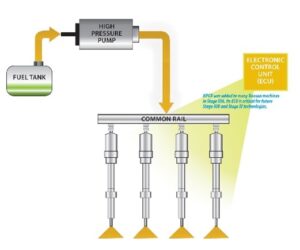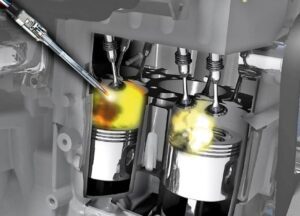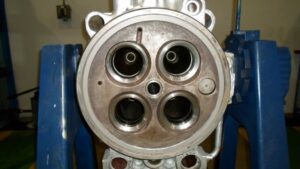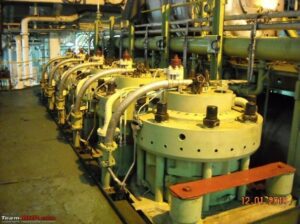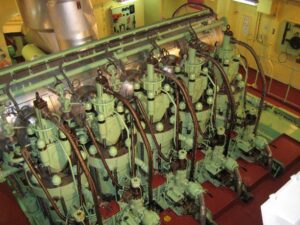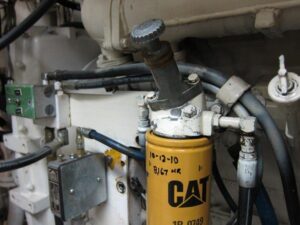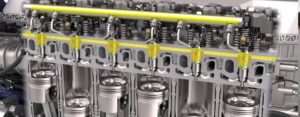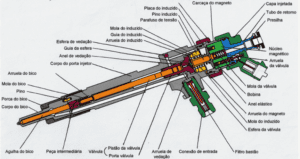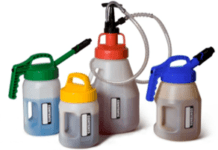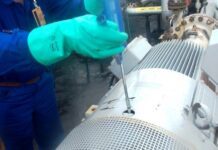
Marcos Thadeu Lobo
Mechanical Engineer Graduated from the State University of Campinas (Unicamp). He currently works as an Associate Consultant at QU4TTUOR CONSULTORIA.
Injection System
1.1– INTRODUCTION
The fuel system is the most sophisticated, most expensive, and most critical of all Cyclo Diesel 4T internal combustion engine systems. The performance of Cyclo Diesel 4T internal combustion engines, fuel economy, and durability depend fundamentally on the fuel system.
Images 1 and 2 – Fuel system: high repair cost.
Use high-quality fuel (Road Diesel Oil B S500/B S10; OC A1; Marine Diesel Oil DMA/DMB; OCM 120/180/380) with the appropriate General Cleanliness Level and high-efficiency fuel filters (Beta and Properly sized Average Pores) will allow the fuel system components to operate properly until the Cycle Diesel 4T internal combustion engine reaches the end of its service life.
Fuel system failures are most often due to accelerated wear due to abrasion or jamming of injection units and can have a side effect damage to valve train components. We can mention this situation:
- Shortening the life of the injectors due to the excess of abrasive solid particulate material present in the fuel;
- The solid abrasive particulate material of microscopic dimensions causes damage to the metal surfaces of the injection units, results in leaks in the high-pressure areas of the fuel system, and loss of power in internal combustion engines Ciclo Diesel 4T;
- The abrasive solid particulate material is present in most fuels used in Diesel 4T Cycle internal combustion engines. It happens, however, that, in some situations, the amount of abrasive solid particulate material is very high and extremely critical.

 Images 3/4 – Modern injection units demand fuel with excellent General Cleanliness Level: very small dynamic gaps.
Images 3/4 – Modern injection units demand fuel with excellent General Cleanliness Level: very small dynamic gaps.
The intent of this white paper is to provide information on how fuel systems operate, the damage caused by fuel contamination by water, abrasive solid particulate matter, and what can be done to prevent such damage.
1.2 – BASIC COMPOSITION OF A FUEL SYSTEM
A fuel system used in 4T Diesel Cycle internal combustion engines is basically composed of:
a) Fuel transfer pump activated by the crankshaft of the internal combustion engine Ciclo Diesel 4T;
b) Primary fuel filtration system (eg 10 microns);
c) Secondary fuel filtration system (eg 2 micron – 4 micron);
d) Fuel injection units;
e) Fuel pressure regulating valve;
f) Flexible hoses;
g) Hand pump for priming fuel (purging or “bleeding” air in the fuel system).
 Image 5 – Fuel system scheme in Diesel Cycle engine.
Image 5 – Fuel system scheme in Diesel Cycle engine.
The crankshaft-driven fuel transfer pump dispenses fuel to the injection units through the secondary fuel filtration system. This pump is equipped with a safety valve so that the fuel flow varies according to the service rotation (rpm) and technical design data. The injection units, actuated by mechanical or hydraulic means, combine the functions of pumping, measuring, and injection in a single part.
The injection units are located near the center of the combustion chamber in the head of each cylinder, between the swing arms of the rocker arms. External distribution lines carry the fuel dispensed from the transfer pump to the injection units, thus eliminating the need for high-pressure lines.
Images 6/7 – Injection units: near the center of the combustion chamber.
The fuel circulates continuously through the injection units and the surplus, not used in the combustion process, will serve to cool the injection units and will return to the fuel tank through the pressure regulating valve. This excess fuel also helps to purge air from the fuel system.
The pressure in the fuel line that supplies the injection units is controlled by means of a pressure regulating valve. The pressure regulating valve must be adjusted as directed by the OEM to provide adequate fuel pressure in the fuel line feeding the injection units.
Images 8/9 – Injection units fixed on individual heads..
The manual fuel priming pump is recommended if the electric version is not available. The manual fuel priming pump assists in purging (“bleeding”) the air in the fuel lines before the Diesel Cycle 4T internal combustion engine goes into operation and after maintenance activities such as filter element changes and replacement of injection units. It is customary to use, also, duplex-type primary fuel filters before the fuel pump driven by the internal combustion engine Cycle Diesel 4T, installed at a remote point in the suction line of the fuel transfer pump.
Images 10/11 – Manual pump for priming air and duplex primary filters.
The main types of fuel injection systems in Diesel 4T Cycle internal combustion engines are:
1.2.1 – HEUI SYSTEM – HYDRAULICALLY ACTUATED ELECTRONICALLY CONTROLLED UNIT INJECTORS
This type of fuel injection system uses a hydraulic pump and lubricating oil from the 4T Cycle Diesel internal combustion engine to generate fuel injection pressure and an ECM (Electronic Control Module) to control pressure and volume of fuel injected into the cylinders. The operation of the HEUI fuel injection system is completely different from any other type of mechanically actuated fuel injection system.
The HEUI fuel injection system is completely free of adjustments since changes in the operating regime in order to change performance is only possible by installing new software in the ECM (Electronic Control Module).
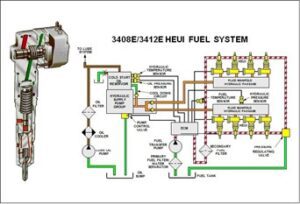
 Images 12/13 – HEUI Fuel Injection System
Images 12/13 – HEUI Fuel Injection System
1.2.2 – MEUI SYSTEM – MECHANICALLY ACTUATED ELECTRONICALLY CONTROLLED UNIT INJECTORS
This type of injection system also uses the camshaft, tappets, rods and rocker arms to generate injection pressure. An ECM (Electronic Control Module – Electronic Control Module) is used to control the volume of fuel to be injected into the combustion chamber of the Diesel 4T engine.

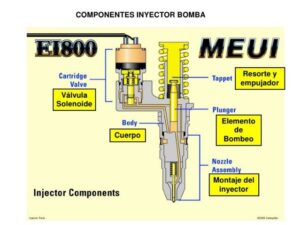 Images 14/15 – MEI injection system.
Images 14/15 – MEI injection system.
A solenoid valve on each injection unit will receive voltage pulses to become energized and will inject fuel while energized. The ECM adjusts the volume of fuel injected into the combustion chamber by varying the voltage pulses sent to each injection unit. By controlling the start and duration of the voltage pulses, it is possible to adjust the start of fuel injection into the combustion chamber and the volume of fuel to be injected.
1.2.3 – COMMON RAIL FUEL INJECTION SYSTEM
Unlike the MEUI (Mechanically Actuated Electronically Controlled Unit Injectors) fuel injection system in the Common Rail fuel injection system, the injection pressure for the injection units is generated externally by means of a high-pressure pump driven by the internal combustion engine Cycle Diesel 4T. The high-pressure pump pressurizes the high-pressure fuel accumulator tube (Common Rail) located on the side(s) of the Diesel 4T Cycle internal combustion engine that supplies the injection units with fuel at high pressure. Electronic injection units in each cylinder control the start and duration of fuel injection. Like other fuel injection systems, the Common Rail injection system has the ability to perform multiple injections (pre-injection, main injection, and secondary injection) during the combustion engine time.
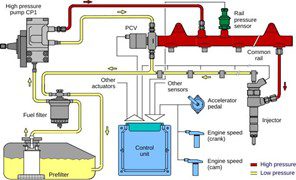
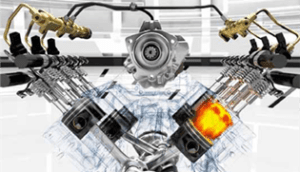 Images 16/17 – Common Rail fuel injection system.
Images 16/17 – Common Rail fuel injection system.
The main components of a Common Rail injection system are the ECM (Electronic Control Module – Electronic Control Module), high-pressure pump, high-pressure lines, Rail and injection units. The components in the low-pressure region are similar to those in individual injection systems (HEUI; MEUI). Fuel in the Common Rail injection system does not circulate continuously as with individual injection systems (HEUI; MEUI). Instead, small volumes of fuel are dispensed during the injection process.
Images 18/19 – Common Rail injection system components.
Due to the extremely high pressure existing in the Rail, the fuel is at higher temperatures when compared to the individual injection systems (HEUI, MEUI), requiring that the fuel inlet temperature in the Rail remains within the parameters established by the OEM of the diesel engine. In some cases, it is even necessary to use a heat exchanger to keep the fuel inlet temperature in the Rail within acceptable limits.

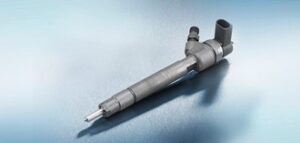 Images 20/21 – Fuel is the lubricant of moving components.
Images 20/21 – Fuel is the lubricant of moving components.
If the Rail fuel inlet temperature is not kept within acceptable parameters, the Kinematic Viscosity will be so low as to not provide a lubricating film with sufficient strength to lubricate the components of the injection system, particularly the injection units that , additionally, are very susceptible to abrasive or corrosive wear caused by contaminants (eg water, abrasive solid particulate material). Once again, the importance of proper filtration of the fuel that will be used in Common Rail injection systems is highlighted.
Images 22/23 – Fuel viscosity is extremely important in the lubrication of injection units and high-pressure pump.




